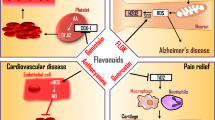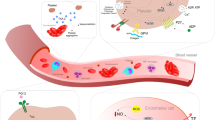Abstract
Introduction
Flavocoxid, a botanical, anti-inflammatory agent, nonspecifically inhibits the peroxidase activity of cyclooxygenase (COX-1 and COX-2) enzymes and 5-lipooxygenase (5-LOX). Due to the concomitant use of aspirin or warfarin in many osteoarthritis (OA) patients with increased cardiovascular risk, we felt it necessary to assess the anticoagulation properties of flavocoxid.
Methods
Three different studies were used: 1) a mouse model to assess effects on bleeding times when combined with aspirin; 2) the effect on platelet function as evaluated by platelet aggregation and bleed times in healthy human subjects; and 3) the effect on international normalized ratio in previously warfarinized patients with OA.
Results
Flavocoxid at a human equivalent dose (HED) of 569 mg (within the standard human dosing range of 500 mg) produced no significant increases in bleeding time in mice. There was also no inhibition or synergistic increase in bleed times when flavocoxid was combined with aspirin (370 mg HED). Flavocoxid did not significantly inhibit thromboxane production or platelet aggregation, and did not increase bleeding times in healthy volunteers. Finally, flavocoxid did not inhibit or potentiate the anticoagulant effect of warfarin.
Conclusion
These results suggest that flavocoxid does not affect the primary or extrinsic pathways of secondary hemostasis and, by not inhibiting the anticoagulation effects of aspirin, may have utility in cardiovascular patients with OA.
Similar content being viewed by others
References
Burnett BP, Levy R, Cole BJ. Metabolic mechanisms in the pathogenesis of osteoarthritis. A review. J Knee Surg. 2006;19:191–197.
Paulus HE. FDA arthritis advisory committee meeting: serious gastrointestinal toxicity of nonsteroidal anti-inflammatory drugs, etc. Arthritis Rheum. 1988;31:1450–1451.
Garcia Rodriguez LA, Jick H. Risk of upper gastrointestinal bleeding and perforation associated with individual non-steroidal anti-inflammatory drugs. Lancet. 1994;343:769–772.
Cronberg S, Wallmark E, Soderberg I. Effect on platelet aggregation of oral administration of 10 non-steroidal analgesics to humans. Scand J Haematol. 1984;33:155–159.
Roth GJ, Stanford N, Majerus PW. Acetylation of prostaglandin synthase by aspirin. Proc Natl Acad Sci U S A. 1975;72:3073–3076.
Van Hecken A, Schwartz JI, Depré M, et al. Comparative inhibitory activity of rofecoxib, meloxicam, diclofenac, ibuprofen, and naproxen. J Clin Pharmacol. 2000;40:1109–1120.
Awtry EH, Loscalzo J. Aspirin. Circulation. 2000;101:1206–1218.
Catella-Lawson F, Reilly MP, Kapoor SC, et al. Cyclooxygenase inhibitors and the antiplatelet effects of aspirin. N Engl J Med. 2001;345:1809–1817.
Capone ML, Sciulli MG, Tacconelli S, et al. Pharmacodynamic interaction of naproxen with low-dose aspirin in healthy subjects. J Am Coll Cardiol. 2005;45:1295–1301.
Kurth T, Glynn RJ, Walker AM, et al. Inhibition of clinical benefits of aspirin on first myocardial infarction by nonsteroidal antiinflammatory drugs. Circulation. 2003;108:1191–1195.
Greenberg HE, Gottesdiener K, Huntington M, et al. A new cyclooxygenase-2 inhibitor, rofecoxib (VIOXX), did not alter the antiplatelet effects of low-dose aspirin in healthy volunteers. J Clin Pharmacol. 2000;40:1509–1515.
Leese PT, Hubbard RC, Karim A, Isakson PC, Yu SS, Geis GS. Effects of celecoxib, a novel cyclooxygenase-2 inhibitor, on platelet function in healthy adults: a randomized, controlled trial. J Clin Pharmacol. 2000;40:124–132.
Holbrook AM, Pereira JA, Labiris R, et al. Systematic overview of warfarin and its drug and food interactions. Arch Intern Med. 2005;165:1095–1106.
Chan TY. Prolongation of prothrombin time with the use of indomethacin and warfarin. Br J Clin Pract. 1997;51:177–178.
Rhodes RS, Rhodes PJ, Klein C, Sintek CD. A warfarin-piroxicam drug interaction. Drug Intell Clin Pharm. 1985;19:556–558.
Schwartz JI, Bugianesi KJ, Ebel DL, et al. The effect of rofecoxib on the pharmacodynamics and pharmcokinetics of warfarin. Clin Pharmacol Ther. 2000;68:626–636.
Karim A, Tolbert D, Piergies A, et al. Celecoxib does not significantly alter the pharmacokinetics or hypoprothrombinemic effect of warfarin in healthy subjects. J Clin Pharmacol. 2000;40:655–663.
Wittkowsky AK, Boccuzzi SJ, Wogen J, Wygant G, Patel P, Hauch O. Frequency of concurrent use of warfarin with potentially interacting drugs. Pharmacotherapy. 2004;24:1668–1674.
Battistella M, Mamdami MM, Juurlink DN, Rabeneck L, Laupacis A. Risk of upper gastrointestinal hemorrhage in warfarin users treated with nonselective NSAIDs or COX-2 inhibitors. Arch Intern Med. 2005;165:189–192.
Chan TY. Adverse interactions between warfarin and nonsteroidal antiinflammatory drugs: mechanisms, clinical significance, and avoidance. Ann Pharmacother. 1995;29:1274–1283.
Shorr RI, Ray WA, Daugherty JR, Griffin MR. Concurrent use of nonsteroidal anti-inflammatory drugs and oral anticoagulants places elderly persons at high risk for hemorrhagic peptic ulcer disease. Arch Intern Med. 1993;153:1665–1670.
FDA web site. FDA Announces Series of Changes to the Class of Marketed Non-Steroidal Anti-Inflammatory Drugs (NSAIDs). April 7, 2005, Available at: www.fda.gov/NewsEvents/Newsroom/PressAnnouncements/2005/ucm108427.htm. Accessed: May 26, 2010.
Altavilla D, Squadrito F, Bitto A, et al. Flavocoxid, a dual inhibitor of cyclooxygenase and 5-lipoxygenase, blunts pro-inflammatory phenotype activation in endotoxin stimulated macrophages. Br J Pharmacol. 2009;157:1410–1418.
Jia Q. Generating and screening a natural product library for cyclooxygenase and lipoxygenase dual inhibitors. Studies in Natural Product Chemistry. 2003;29:P643–P718.
Butler KD, Maguire ED, Smith JR, Turnbull AA, Wallis RB, White AM. Prolongation of rat tail bleeding time caused by oral doses of a thromboxane synthetase inhibitor which have little effect on platelet aggregation. Thromb Haemost. 1982;47:46–49.
Weiss HJ. Platelet physiology and abnormalities of platelet function (first of two parts). N Engl J Med. 1975;293:531–541.
Martel-Pelletier J, Lajeunesse D, Reboul P, Pelletier JP. Therapeutic role of dual inhibitors of 5-LOX and COX, selective and non-selective non-steroidal anti-inflammatory drugs. Ann Rheum Dis. 2003;62:501–509.
Levy R, Saikovsky R, Shmidt E, Khokhlov A, Burnett BP. Flavocoxid is as effective as naproxen for managing the signs and symptoms of osteoarthritis of the knee in humans: a short-term randomized, double-blind pilot study. Nutr Res. 2009;29:298–304.
Pillai L, Burnett BP, Levy RM. GOAL: multicenter, open-label, post-marketing study of flavocoxid, a novel dual pathway inhibitor anti-inflammatory agent of botanical origin. Curr Med Res Opin. 2010;26:1055–1063.
Cooper R, Morre DJ, Morre DM. Medicinal benefits of green tea: Part I. Review of noncancer health benefits. J Altern Complement Med. 2005;11:521–528.
Shao ZH, Vanden Hoek TL, Qin Y, et al. Baicalein attenuates oxidant stress in cardiomyocytes. Am J Physiol Heart Circ Physiol. 2002;282:H999–H1006.
Institute of Laboratory Animal Research, Commission on Life Sciences, National Research Council. Guide for the Care and Use of Laboratory Animals. Washington, DC: National Academy Press; 1996.
Burnett BP, Jia Q, Zhao Y, Levy RM. A medicinal extract of Scutellaria baicalensis and Acacia catechu acts as a dual inhibitor of cyclooxygenase and 5-lipoxygenase to reduce inflammation. J Med Food. 2007;10:442–451.
Graff J, Skarke C, Klinkhardt U, et al. Effects of selective COX-2 inhibition on prostanoids and platelet physiology in young healthy volunteers. J Thromb Haemost. 2007;5:2376–2385.
Mielke CH, Jr., Kaneshiro MM, Maher IA, Weiner JM, Rapaport SI. The standardized normal ivy bleeding time and its prolongation by aspirin. Blood. 1969;34:204–215.
Escolar G, Cases A, Vinas M, et al. Evaluation of acquired platelet dysfunctions in uremic and cirrhotic patients using the platelet function analyzer (PFA-100): influence of hematocrit elevation. Haematologica. 1999;84:614–619.
Guerrero JA, Navarro-Nunez L, Lozano ML, et al. Flavonoids inhibit the platelet TxA(2) signalling pathway and antagonize TxA(2) receptors (TP) in platelets and smooth muscle cells. Br J Clin Pharmacol. 2007;64:133–144.
Burnett BP, Pillai L, Levy RM: editors. Flavocoxid, a natural novel flavonoid-based anti-inflammatory with a broad mechanism of action provides safe and effective inflammatory management of disease. Phoenix, AZ: Society for Biomolecular Science; 2010.
Son DJ, Cho MR, Jin YR, et al. Antiplatelet effect of green tea catechins: a possible mechanism through arachidonic acid pathway. Prostaglandins Leukot Essent Fatty Acids. 2004;71:25–31.
Heptinstall S, May J, Fox S, Kwik-Uribe C, Zhao L. Cocoa flavanols and platelet and leukocyte function: recent in vitro and ex vivo studies in healthy adults. J Cardiovasc Pharmacol. 2006;47(suppl. 2):S197–205.
Pignatelli P, Pulcinelli FM, Celestini A, et al. The flavonoids quercetin and catechin synergistically inhibit platelet function by antagonizing the intracellular production of hydrogen peroxide. Am J Clin Nutr. 2000;72:1150–1155.
Liu JJ, Huang TS, Cheng WF, Lu FJ. Baicalein and baicalin are potent inhibitors of angiogenesis: Inhibition of endothelial cell proliferation, migration and differentiation. Int J Cancer. 2003;106:559–565.
Navarro-Nunez L, Castillo J, Lozano ML, et al. Thromboxane A2 receptor antagonism by flavonoids: structure-activity relationships. J Agric Food Chem. 2009;57:1589–1594.
Selg E, Buccellati C, Andersson M, et al. Antagonism of thromboxane receptors by diclofenac and lumiracoxib. Br J Pharmacol. 2007;152:1185–1195.
Burnett BP, Silva S, Mesches MH, Jia Q. Safety Evaluation of a combination, defined extract of Scutellaria baicalensis and Acacia catechu. J Food Biochem. 2007;31:797–825.
Morgan SL, Baggott JE, Moreland L, Desomond R, Kendrach A. The safety of flavocoxid, a medical food, in the dietary management of knee osteoarthritis. J Medicinal Foods. 2009;12:1143–1148.
Kirchheiner J, Brockmoller J. Clinical consequences of cytochrome P450 2C9 polymorphisms. Clin Pharmacol Ther. 2005;77:1–16.
Aithal GP, Day CP, Kesteven PJ, Daly AK. Association of polymorphisms in the cytochrome P450 CYP2C9 with warfarin dose requirement and risk of bleeding complications. Lancet. 1999;353:717–719.
Levy RM, Pillai L, Burnett BP. Nutritional benefits of flavocoxid in patients with osteoarthritis: efficacy and safety. Nutr Diet Supple. 2010;2:1–12.
Davies NM, McLachlan AJ, Day RO, Williams KM. Clinical pharmacokinetics and pharmacodynamics of celecoxib: a selective cyclo-oxygenase-2 inhibitor. Clin Pharmacokinet. 2000;38:225–242.
Malhi H, Atac B, Daly AK, Gupta S. Warfarin and celecoxib interaction in the setting of cytochrome P450 (CYP2C9) polymorphism with bleeding complication. Postgrad Med J. 2004;80:107–109.
Gabb GM. Fatal outcome of interaction between warfarin and a non-steroidal anti-inflammatory drug. Med J Aust. 1996;164:700–701.
Geleijnse JM, Launer LJ, Hofman A, Pols HA, Witteman JC. Tea flavonoids may protect against atherosclerosis: the Rotterdam Study. Arch Intern Med. 1999;159:2170–2174.
Hertog MG, Feskens EJ, Hollman PC, Katan MB, Kromhout D. Dietary antioxidant flavonoids and risk of coronary heart disease: the Zutphen Elderly Study. Lancet. 1993;342:1007–1011.
Limbrel web site. Limbrel Post Marketing Surveillance. Primus Pharmaceuticals; 2010. Available at: www.limbrel.com/downloads/post_mkt_surv.pdf. Accessed December 1, 2009.
Author information
Authors and Affiliations
Corresponding author
Rights and permissions
About this article
Cite this article
Pillai, L., Levy, R.M., Yimam, M. et al. Flavocoxid, an anti-inflammatory agent of botanical origin, does not affect coagulation or interact with anticoagulation therapies. Adv Therapy 27, 400–411 (2010). https://doi.org/10.1007/s12325-010-0040-7
Received:
Published:
Issue Date:
DOI: https://doi.org/10.1007/s12325-010-0040-7




